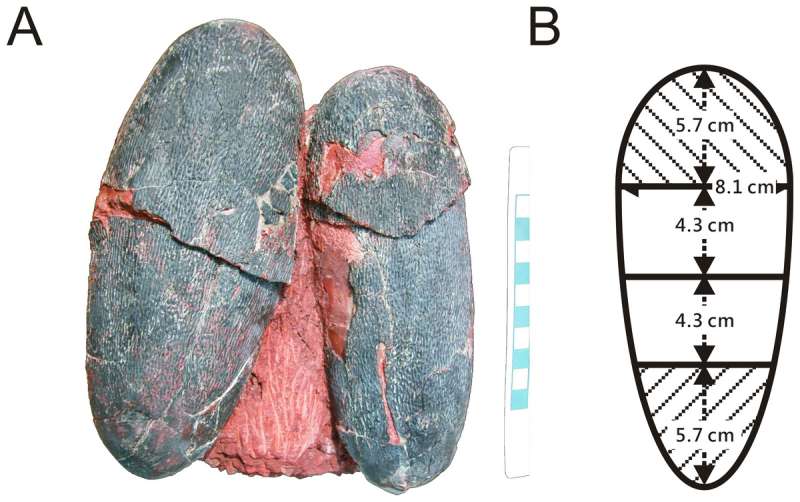September 20, 2017 report
Non-avian dinosaur found to have laid blue eggs

(Phys.org)—A team of researchers from Germany and the U.S. has found that a non-avian dinosaur living in what is now China laid colored eggs. In their paper published on the peer-reviewed site PeerJ, the team describes their study of the egg fossils and what their findings suggest about the evolution of colored eggs in modern birds.
Many modern birds lay colored eggs—some are monochrome, like blue robin's eggs; others are multi-colored like those of the dove. But until now, it was believed that all dinosaur eggs were white because dinosaurs laid their eggs in protected nests. In this new effort, the researchers have found an example of a dinosaur that laid blue or green eggs.
The team reports that theirs was the first effort to seriously study color in dinosaur eggs. It came about after the team noted some Heyuannia huangi fossilized eggs that had a bluish tint—researchers had previously assumed the tint was due to mineralization, but the new team thought maybe there was more to it. Prior research had shown that Heyuannia huangi were dinosaurs with parrot-like beaks that walked on hind legs. The team used mass spectrometry and chromatographic separation to take a closer look at the eggs and detected traces of biliverdin and protoporphyrin, pigments commonly found in modern colored bird eggs. The eggs were also dated back to the Late Cretaceous period, which ran from 100 to 66 million years ago.
The oviraptor Heyuannia huangi were also feathered dinosaurs—many of their fossils have been found over the years, but until now, no one suspected that they laid colored eggs. The coloring, the team suggests, is a strong indication that the eggs were laid in open nests—the coloring would have served as camouflage. In modern birds, only those that lay them in open nests are colored. Their finding also shows that egg coloring began before the evolution of modern birds—it started with non-avian dinosaurs and was passed down to modern ancestors.
The researchers report that as a result of their find, they are taking a look at other fossilized dinosaur eggs to see if perhaps some of those also were colored.
More information: Jasmina Wiemann et al. Dinosaur origin of egg color: oviraptors laid blue-green eggs, PeerJ (2017). DOI: 10.7717/peerj.3706
Abstract
Protoporphyrin (PP) and biliverdin (BV) give rise to the enormous diversity in avian egg coloration. Egg color serves several ecological purposes, including post-mating signaling and camouflage. Egg camouflage represents a major character of open-nesting birds which accomplish protection of their unhatched offspring against visually oriented predators by cryptic egg coloration. Cryptic coloration evolved to match the predominant shades of color found in the nesting environment. Such a selection pressure for the evolution of colored or cryptic eggs should be present in all open nesting birds and relatives. Many birds are open-nesting, but protect their eggs by continuous brooding, and thus exhibit no or minimal eggshell pigmentation. Their closest extant relatives, crocodiles, protect their eggs by burial and have unpigmented eggs. This phylogenetic pattern led to the assumption that colored eggs evolved within crown birds. The mosaic evolution of supposedly avian traits in non-avian theropod dinosaurs, however, such as the supposed evolution of partially open nesting behavior in oviraptorids, argues against this long-established theory. Using a double-checking liquid chromatography ESI-Q-TOF mass spectrometry routine, we traced the origin of colored eggs to their non-avian dinosaur ancestors by providing the first record of the avian eggshell pigments protoporphyrin and biliverdin in the eggshells of Late Cretaceous oviraptorid dinosaurs. The eggshell parataxon Macroolithus yaotunensis can be assigned to the oviraptor Heyuannia huangi based on exceptionally preserved, late developmental stage embryo remains. The analyzed eggshells are from three Late Cretaceous fluvial deposits ranging from eastern to southernmost China. Reevaluation of these taphonomic settings, and a consideration of patterns in the porosity of completely preserved eggs support an at least partially open nesting behavior for oviraptorosaurs. Such a nest arrangement corresponds with our reconstruction of blue-green eggs for oviraptors. According to the sexual signaling hypothesis, the reconstructed blue-green eggs support the origin of previously hypothesized avian paternal care in oviraptorid dinosaurs. Preserved dinosaur egg color not only pushes the current limits of the vertebrate molecular and associated soft tissue fossil record, but also provides a perspective on the potential application of this unexplored paleontological resource.
Journal information: PeerJ
© 2017 Phys.org



















